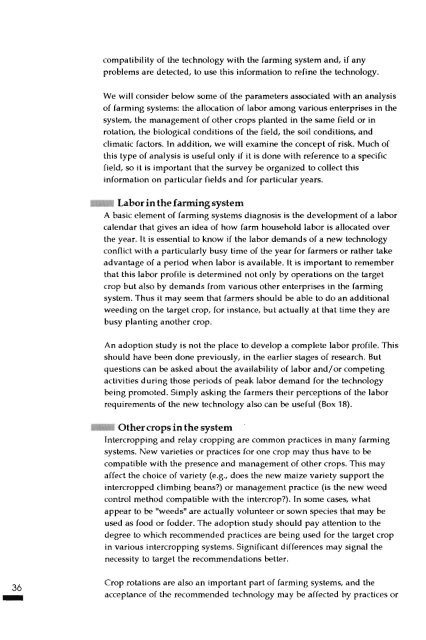The Adoption of Agricultural Technology - Food Security Group
The Adoption of Agricultural Technology - Food Security Group
The Adoption of Agricultural Technology - Food Security Group
You also want an ePaper? Increase the reach of your titles
YUMPU automatically turns print PDFs into web optimized ePapers that Google loves.
compatibility <strong>of</strong> the technology with the farming system and, if anyproblems are detected, to use this information to refine the technology.We will consider below some <strong>of</strong> the parameters associated with an analysis<strong>of</strong> farming systems: the allocation <strong>of</strong> labor among various enterprises in thesystem, the management <strong>of</strong> other crops planted in the same field or inrotation, the biological conditions <strong>of</strong> the field, the soil conditions, andclimatic factors. In addition, we will examine the concept <strong>of</strong> risk. Much <strong>of</strong>this type <strong>of</strong> analysis is useful only if it is done with reference to a specificfield, so it is important that the survey be organized to collect thisinformation on particular fields and for particular years.Laborinthefanning systemA basic element <strong>of</strong> farming systems diagnosis is the development <strong>of</strong> a laborcalendar that gives an idea <strong>of</strong> how farm household labor is allocated overthe year. It is essential to know if the labor demands <strong>of</strong> a new technologyconOict with a particularly busy time <strong>of</strong> the year for farmers or rather takeadvantage <strong>of</strong> a period when labor is available. It is important to rememberthat this labor pr<strong>of</strong>ile is determined not only by operations on the targetcrop but also by demands from various other enterprises in the farmingsystem. Thus it may seem that farmers should be able to do an additionalweeding on the target crop, for instance, but actually at that time they arebusy planting another crop.An adoption study is not the place to develop a complete labor pr<strong>of</strong>ile. Thisshould have been done previously, in the earlier stages <strong>of</strong> research. Butquestions can be ,asked about the availability <strong>of</strong> labor and/or competingactivities during those periods <strong>of</strong> peak labor demand for the technologybeing promoted. Simply asking the farmers their perceptions <strong>of</strong> the laborrequirements <strong>of</strong> the new technology also can be useful (Box 18).Othercrops inthe systemlntercropping and relay cropping are common practices in many farmingsystems. New varieties or practices for one crop may thus have to becompatible with the presence and management <strong>of</strong> other crops. This mayaffect the choice <strong>of</strong> variety (e.g., does the new maize variety support theintercropped climbing beans?) or management practice (is the new weedcontrol method compatible with the intercrop?). In some cases, whatappear to be "weeds" are actually volunteer or sown species that may beused as food or fodder. <strong>The</strong> adoption study should pay attention to thedegree to which recommended practices are being used for the target cropin various intercropping systems. Significant differences may Signal thenecessity to target the recommendations better.-36Crop rotations are also an important part <strong>of</strong> farming systems, and theacceptance <strong>of</strong> the recommended technology may be affected by practices or



